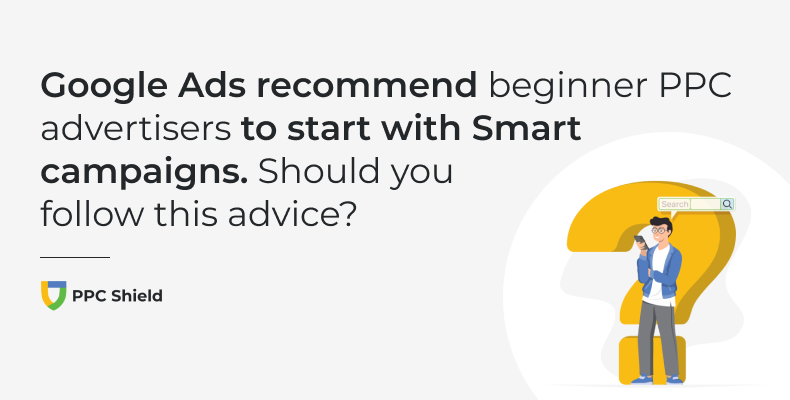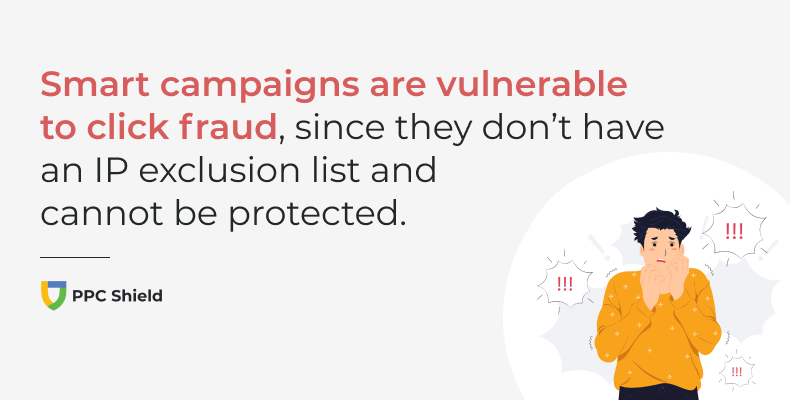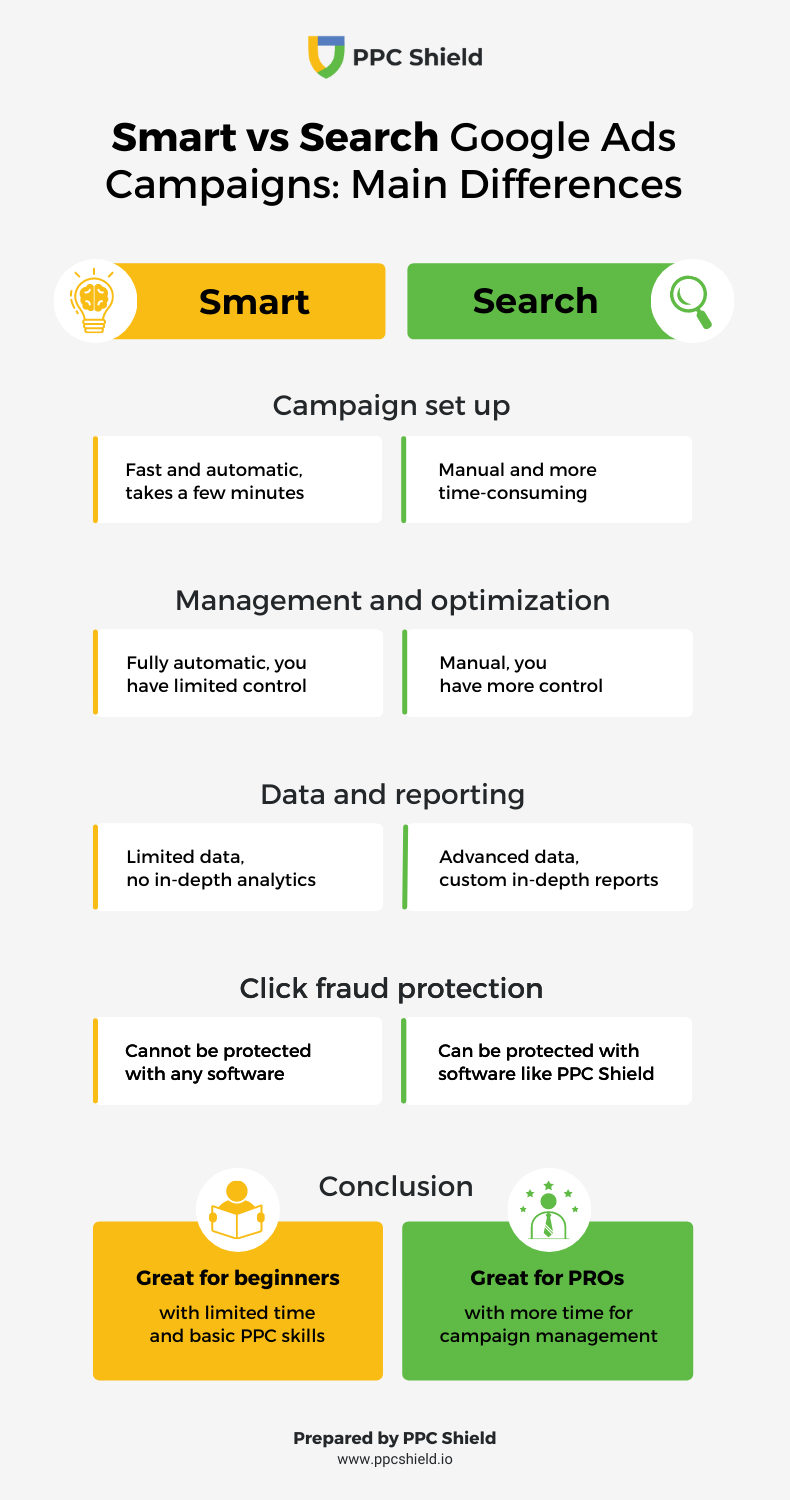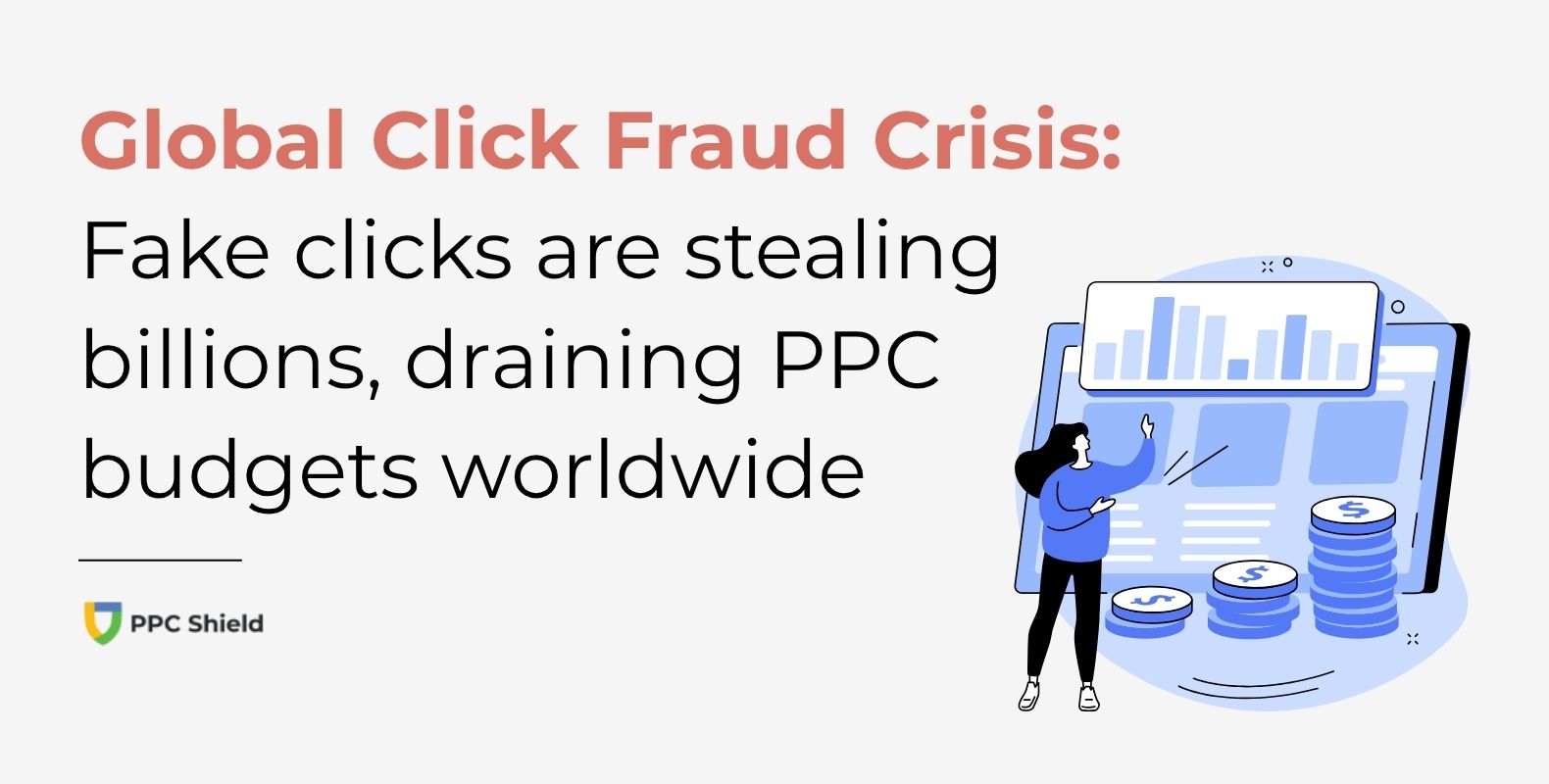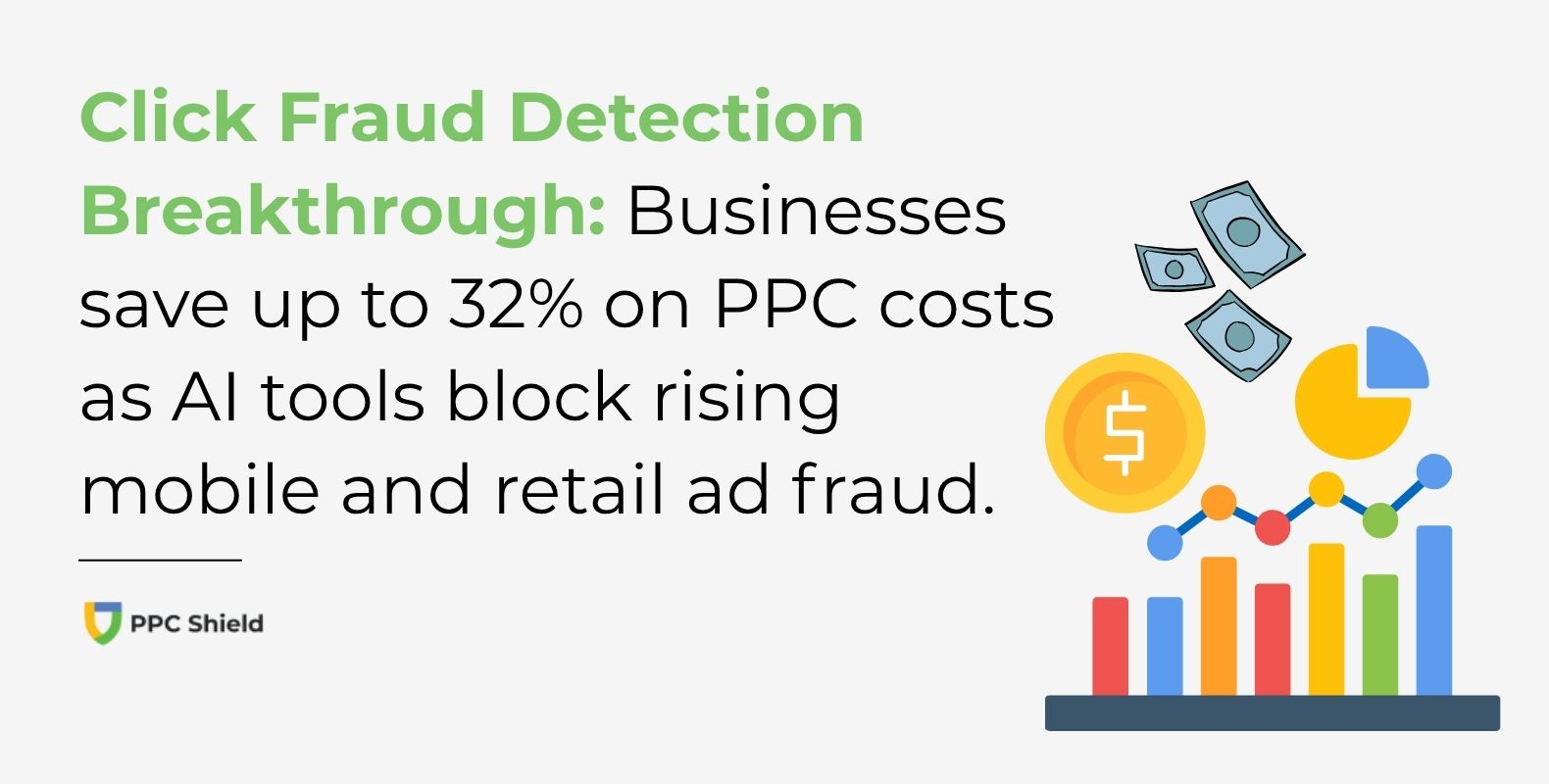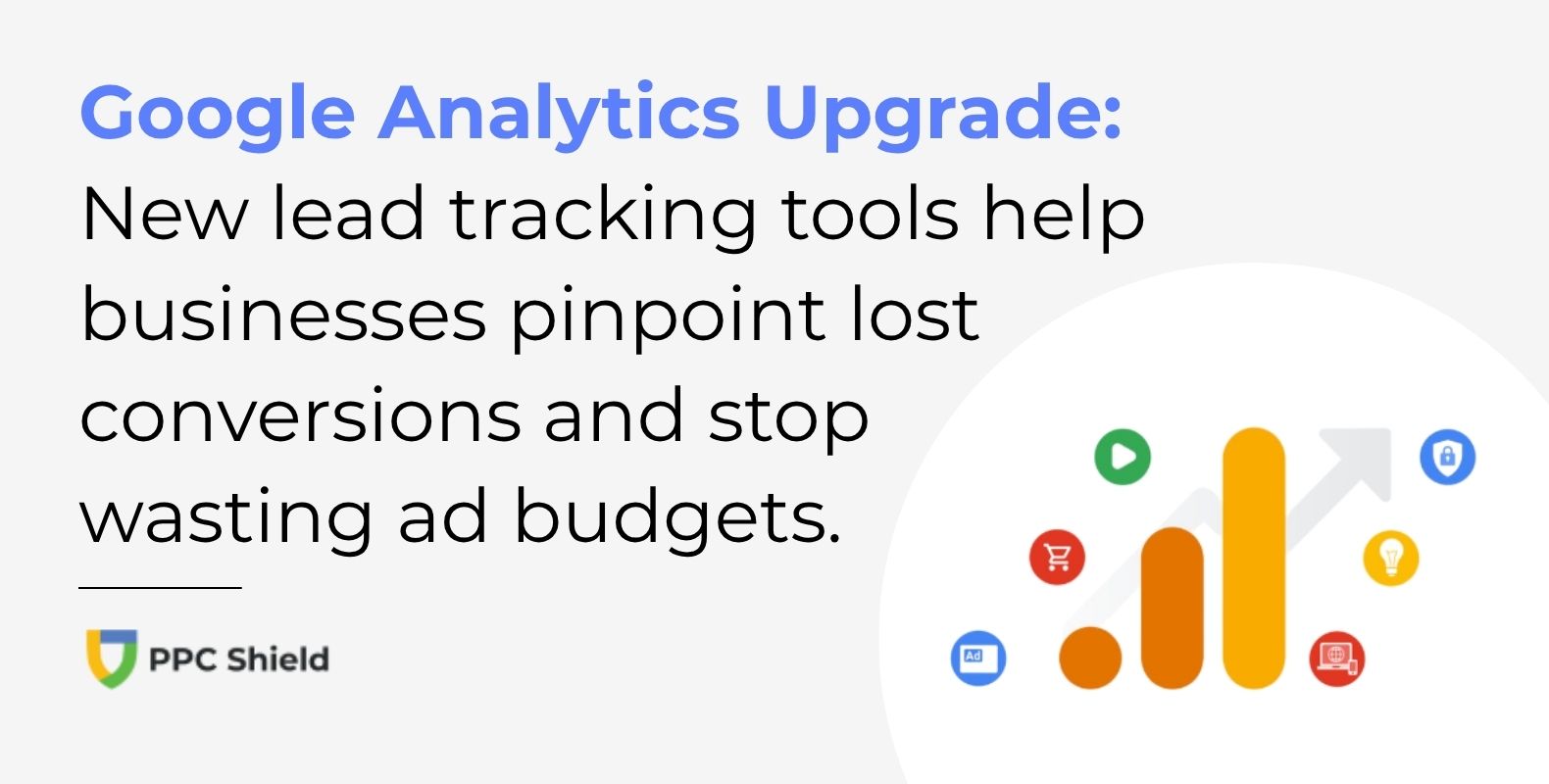Smart vs Search Campaigns: Which Should You Use in 2024?
Here is an ultimate guide to Smart and Search campaigns, differences between them and optimization tips. First, let’s walk through the main types of Google Ads campaigns.
If you already know the basics, navigate to the following sections:
Overview of Google Ads campaign types
Smart campaigns are automatically set up and optimized for you, and require minimal effort on your side.
You can run Smart Search, Shopping and Display campaigns. Google Ads’ algorithms will find the best targeting and bidding strategies to reach your business goals.
This type of campaigns can be used for one of the following goals: get calls, get visits to the physical location, get website traffic, sales and sign-ups.
Are smart campaigns right for you? Compare Smart and Search campaigns and decide for yourself.
These are text ads that appear on top or bottom of the search results page. They appear when a person searches for something on Google search.
Search campaigns allow you to place different bids across ad groups and keywords, which is one of several factors that will determine the position of your ads in the search results page among your competitors and organic results.
This type of campaign allows you to drive traffic to your website and to generate conversions while maintaining better control of your bids and budget.
Effectiveness of a text ad greatly depends on the ad copy. You cannot use images of videos in such ads, therefore strong text is the only way to stand out and attract clicks.
Display ads are shown on third-party websites in the Google Display Network (GDN).
Display ads use a combination of creative assets: headlines and descriptions, images, videos and a logo.
This type of ads is great for building awareness about your brand, product or service, bringing additional traffic to your website from different audiences from all sorts of interest groups, and for remarketing.
This type of ads let you place your videos on YouTube and other websites that support video ad format (Google video partners). In any case, you have to upload your videos to YouTube first.
Video ads support a range of formats and lengths, they can be skippable or non-skippable.
This is a great type of ads for brand awareness and remarketing.
Shopping ads take product information that you provided in the Merchant Center and display it in many placements: Shopping tab, Google Search results, Google Images, Google Display Network, and Google Search Partner websites.
There are two types of Shopping ads: Product Shopping ads and Local inventory ads.
If you are running Shopping ads, make sure the information in your Merchant Center is accurate and up-to-date.
This campaign type takes information from your app and creates ads for the following purposes: app installs, app engagement, or pre-registration.
You can use App ads for both engaging existing app users and getting new users to install it.
App ads are displayed in Search, Google Play, YouTube, Discovery, and a network of partner websites and apps.
If you have a physical location (shop, restaurant, concert hall etc.), local ads are a great way to bring people there.
Using local campaigns, you can promote store sales, in-person events and promotions. You can also use local ads to inform potential visitors about your business hours and address.
Local ads can be displayed on Google Maps, Google Search, YouTube, and Google Display Network.
What are Smart campaigns and how they work
Because of the fast setup and easy management, Google Ads Smart campaigns are loved by many beginner PPC campaign managers, and not only. This campaign type lets you set up a campaign in a few minutes and let it run automatically. You don’t need to do any complex set up or optimize them on your own.
Types of Smart ads
Smart Search Campaigns are text ads that appear in Google Search Results Page (SERP). You’ll need to provide:
- 3 headlines (30 characters max)
- 2 descriptions (90 characters max)
Depending on the available space, the algorithm might show all headlines and descriptions, or only some of them (headline 1, headline 2 and description 1). Also, it will generate alternate ads using the company information provided by you. This way, Google Ads will have more ad variations for testing and determining the best-performing options.
Smart Display Campaigns use your assets (images, logos, headlines, descriptions) and automatically combine them into ads. In a few minutes, your ads are ready to be served across the Google Display Network. Then, the algorithm shows your ads to the most relevant audience with the highest probability of conversions.
Smart Shopping campaigns use machine learning to showcase your product using different types of ads in different placements, including Google Search Network, Google Display Network, YouTube, and Gmail.
It tests various combinations of images and texts and displays the most successful ones. In one Google Ads account, you can run up to 100 Smart Shopping campaigns.
Benefits of Smart campaigns
Fast and easy setup
To get started, provide information about your business and your goals, set the desired budget and location. Then, upload creative assets and text, and Google Ads will do the rest.
Your first campaign can be ready in a few minutes.
Automatic targeting
Based on the information you provided, Google Ads algorithm will find the best-matching audience and optimize it over time.
Automatic bidding
A smart bidding strategy will help optimize your bids to reach maximum results and meet your business goals. Regardless of what bids Google will apply, your campaign will not go over the monthly budget, and you don’t need to monitor it daily.
Automatic optimization
You don’t need to spend hours monitoring your Google Ads account, analyzing the performance and looking for ways to improve it. The algorithm will do it for you.
Little PPC knowledge needed - excellent for beginners!
You don’t need to be a PPC pro to launch your first Smart campaign. Focus on what you know to do best – on running your business, while Smart ads take care of advertising.
Limitations of Smart campaigns
Limited reporting & analytics
For your convenience, Google Ads provides you with a simple dashboard and the most important stats. If you want to have a closer look at other metrics and analyze your ad performance in depth, the given information might not be enough.
Limited control over budget & bidding
While you can set up your average daily budget and maximum monthly budget, you cannot customize your bidding strategy.
No control over individual keywords
Google Ads’ algorithm chooses the most appropriate keywords for your ads, and you cannot set them up on your own.
No control over ad extensions
Ad extensions are created automatically, you cannot modify them or add new ones.
One landing page per campaign
There is no way to set landing pages on the ad level, therefore you are constrained to using one page for the whole campaign.
High risk of click fraud
You might be receiving invalid clicks and have no tools for preventing it. Even if a fraudulent IP is detected, you cannot blacklist it and protect your campaigns from future attacks. Why? Discover in the following section.
How to protect Smart campaigns from click fraud
Unfortunately, there is no way to protect your Smart campaigns from malicious clicks.
All you can do is trust Google Ads filters to block invalid clicks. There is no point in connecting any third-party click fraud prevention software, as it won’t be able to provide any extra protection.
Smart Campaigns don’t have an IP exclusion list, that’s why no software can blacklist a suspicious IP, even if it’s been detected as a fraudulent one. Therefore, your Smart campaigns remain vulnerable to click fraud.
And can you protect Performance Max campaigns from click fraud? Also no. No software can block IPs for Performance Max campaigns and therefore protect you from unwanted clicks.
What are Search campaigns and how they work
Search campaigns are among the most popular and effective types of online advertising.
If you’re new to PPC, you might find it quite challenging to set up your first campaign. While smart campaign set up takes a few minutes, regular Search campaigns require more time and more manual setup.
Don’t worry – once you get a hang of it, you’ll enjoy Search campaigns and their advanced setup. It will give you so much more control and freedom in managing your campaigns – something that smart campaigns cannot provide.
Types of Search ads
Also called expanded text ads, this is the basic type of text ads with three headlines, two descriptions and several extensions. In the extensions, you can provide extra information about your business (for example, your phone number) and give links to different website pages (for example, the list of services, testimonials, or specific landing pages).
Responsive ads are text ads with more options for text combinations and A/B testing.
You can add up to 15 headlines and 4 descriptions, and Google will try different combinations to find the most effective ones.
If you want certain headlines or descriptions to appear in all combinations (let’s say, you want your brand name or your strongest CTA to be included in all ads), you can pin them.
Dynamic ads use content from your website to create ad texts. You’ll have to provide a domain and choose pages. If your site has categories, for example an e-commerce site, you can choose specific categories you want to promote.
Keep in mind: your website should be well-structured and have clear well-written copy and be up-to-date, in order to provide Dynamic ads with relevant information.
Benefits of Search campaigns
Advanced reporting and analytics
Search campaigns let you monitor plenty of metrics, build and customize reports and study your campaign performance in great detail.
Full control over keywords
You can set up individual keywords and match types on the ad group level. This way, you decide when your ads are shown, instead of trusting the choice of keywords to Google Ads.
Control over bidding and budget
You are the one selecting the bidding strategy for every campaign and adjusting it according to your needs. Also, you can set up and change your daily budget any time.
Manual creation of ad extensions
Ad extensions are a helpful addition to your ad, which can feature business information, website links, promotions and more. In search campaigns, you can create them manually.
Multiple landing pages per campaign
You can set landing pages at the ad level and have different pages inside one campaign. This way you can better match the ad message to a relevant landing page and deliver a more tailored ad experience.
Click fraud is not an issue if you have the right protection
While all Google Ads campaigns can be affected by click fraud, the good news – it can be prevented. How? Jump straight to this section to learn more.
Limitations of Search campaigns
Campaign management requires time
It’s pretty risky to run your search campaigns without careful monitoring. Be ready to observe and optimize your campaigns on a daily basis.
Needs manual optimization
While Google Ads offers you optimization tips and recommendations, it is up to you to take decisions. You might be attracted by automatic auto-applied recommendations, introduced by Google Ads last year. Check out this article and learn why allowing Google Ads auto-applied recommendations is NOT a good idea.
Might be challenging for beginners - PPC knowledge needed
In order to manage your Google Search Ads effectively, optimize your performance and reach maximum results, you need to have a good understanding of how PPC works. Ideally, you should also be knowledgeable about the latest Google Ads updates, PPC best practices and different optimization tips.
How to protect Search campaigns from click fraud
Good news is – search campaigns can be protected using click fraud prevention software, such as PPC Shield.
How does it work? PPC Shield analyzes every click in your search campaigns in real time.
Our algorithm detects if they come from genuine users or someone with malicious intent (for example, your competitors searching for your brand name and clicking on your ads to waste your PPC budget). If the click was detected as suspicious, its IP will be blocked from even seeing your ads again.
Protect your Search campaigns now – try PPC Shield for free for 14 days!
Important to know: PPC Shield has been officially listed by Google as a certified click tracker for Google Ads.


